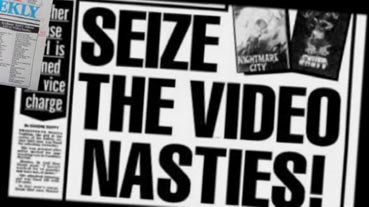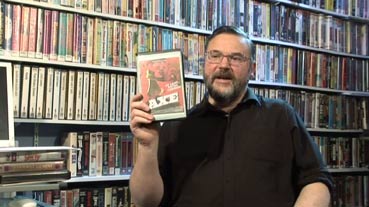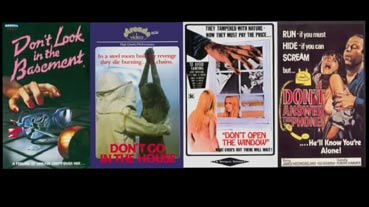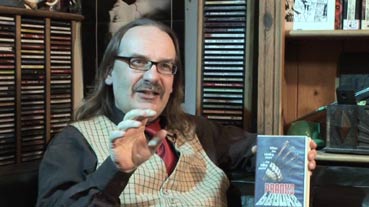|
Video Nasty. Even the term makes me giggle like a schoolgirl. It shouldn't, of course, having been regularly coined by scummy tabloids in scaremongering headlines to condemn and help ban the sort of films with which I spent some of the best parts of my youth. But it's so typical of the yellow press that the best word they could come up with to summarise how sickened they were by these vile and depraved films was "nasty." Oh I know it's true meaning – "highly unpleasant" my dictionary claims – but I whenever I hear the word, the voice of Dorothy Corless cooing "Oh, You Nasty Man" as a musical come-on pops into my head.* Idiots. You'd almost think the term was dreamt up by Lord Toffingham.
Some of you will doubtless be too young to remember the whole ridiculous 'video nasty' furore. If you're a child of the internet generation, where access to just about anything is only a couple of mouse clicks away, then you may well find the whole thing rather bemusing. Older horror fans will likely remember it with a mixture of irritation and affection, a brief period of free access that was crushed by the sort of infuriating, self-appointed morality police who could drive a sane person to unbridled anarchy.

It all kicked off with the advent of home video, which for the first time allowed anyone with access to a video recorder the opportunity to watch movies with any BBFC certification in their own homes. Actually scratch that, they didn't need a BBFC certificate at all, as in what in retrospect seems like a spectacular oversight, movies released for home viewing on VHS or Betamax did not actually require BBFC certification. Brilliant, huh? In what felt a very short space of time, a large number of independent distributors appeared peddling just about any title they could get for a dollar. Many of these were horror cheapies that hadn't even been given a cinema airing and that revelled in the sort of gore and depravity that UK horror fans had until this point been largely denied. This was the early 80s and we were awash with post-Halloween slashers, but the most notorious ones were either cut or had been banned from ever entering our cinemas, and certificate-free home video opened a door through which they could all cheerfully trot. They had great titles, too, genre-specific monikers that shouted their content in seductively lurid terms, films like Zombie Flesh Eaters, The Driller Killer, The Gestapo's Last Orgy (I'm sure they'd been planning to stop them for ages), Night of the Bloody Apes, The Toolbox Murders, Nightmares From a Damaged Brain (how could you not want to see that?) and a whole string of films starting with the word "Cannibal" or "Don't" in the title. And in case words alone failed to outrage the sensitive, the tapes were packaged in cases whose covers were garish enough to bang home the promise of the violence within. Best of the lot was Driller Killer, whose cover boasted a photo of a screaming man with a bloodied face and an electric drill being driven into his forehead. The moment I laid eyes on it, the box was in my hands.
Of course, there was some genuinely poor stuff in there, but this can't be helped when you're trawling for low-budget exploitation flicks, a good many of which would have been made by opportunists with little discernable talent in the hope of making a quick buck. A bit like Hollywood operates now, then. But like the drive-in theatres of the 50s and 60s, independently distributed home video made it possible for genre films that would otherwise have remained largely unseen to find an appreciative audience. It also opened a door for a few inventive young filmmakers looking to make their mark on the movie world in their own unique fashion. Driller Killer, after all, was an early work by American indie favourite Abel Ferrara, whilst The Evil Dead was... oh come on, you don't need me to tell you about that one.

But a number of these films contained the sort of violence and disregard for good taste that anyone with a weed up their arse about what other people watch was simply not prepared to tolerate. Which is one of the reasons we liked them, of course, although the fact that we did so was another cause for consternation, and pretty soon there was a campaign under way to have these films banned. It was kicked off by Mary Whitehouse, a self-righteous religious busybody who claimed to know what was best for pretty much everyone, and the cause was taken up by that most contemptible of tabloids, The Daily Mail, a thoroughly disreputable organ well aware of the positive effect that shock-horror controversy can have on circulation figures. At first we laughed them off, but the Thatcher government of the day was fond of blaming society's ills on things they didn't like, and became vocally determined enforce their bourgeois morality on what they saw as a weak-minded proletariat. People who claimed they don't believe what they read in the papers began believing what they read in the papers, and the campaign, depressingly, started to gather pace. Violent sequences from the films were misleadingly shown out of context (string ten shootings together from a thousand news broadcasts and you'll make a superficially persuasive case that the TV news is excessively violent) and the more lurid box artwork was endlessly paraded as evidence of what these films were doing to our impressionable youth. Tory MP Graham Bright took up the cause and tabled a private members' bill to ban outright films that he to this day describes without a hint of irony as 'evil'. The result was the 1984 Video Recordings Act, which allowed violent films to be classified as obscene and resulted in 39 titles being banned outright and a further 33 being prosecuted but ultimately let off the hook, usually with the offending footage removed. It got to the point where a film was targeted for its title alone, hence the notorious slip-ups that saw the police seizing films like the musical comedy The Best Little Whorehouse in Texas, which starred notorious porn idols Dolly Parton and Burt Reynolds, and Sam Fuller's superb war drama The Big Red One (phoar!).
Uncut versions of the banned movies became objects of desire, and soon reappeared as third-generation tapes to be exchanged in playgrounds and rented under the counter at video rental stores. To have been on the list later became such a badge of honour that distributors of films that had never even been targeted began claiming that they had been, usually to give a limp horror film some undeserved cred. The subsequent relaxation of censorship has not only seen many of these titles released on DVD and Blu-ray in their original, uncut form (four of which have even been reviewed on this site, with a fifth on the way), but the violence that so offended has long since been surpassed in movies that you could comfortably classify as mainstream. A few of the titles have even been subjected to Hollywood remakes that have been distributed in the UK without cuts of any kind. Oh how times change.

Video Nasties: The Definitive Guide, is a three-DVD set from Nucleus Films that sets itself up for a fall with that title. Definitive, huh? You'd better believe it. On hearing of the release I was under the impression that it consisted almost solely of trailers for the films on the Department of Public Prosecution hit list. And sure enough the trailers are all here, split over the first two discs with the banned 39 on disc 1 and the reprieved 33 on disc 2. But every single one of them has an introduction, and, with a couple of exceptions that I'll get to in a minute, they are just superb. A few run for only a couple of minutes, but most are substantial and provide a truckload of background on the film in question and its subsequent banning. And they're delivered by people who are not only hugely knowledgeable about the material they are discussing but – oh praise be – are passionate about it as well. Familiar faces Kim Newman and Alan Jones are joined by a number of other field experts, including Darkside writer Allen Bryce, media and journalism professor Julian Petley, genre writer Marc Morris, and Cult Film Archive director Xavier Mendik. Each gets to introduce a number of the titles and occasionally share the task with more popular films. Newman and Jones are probably the most cynical of the bunch, but still have their favourites and some lovely stories relating to their enjoyment and even love of particular films. With her tattoos, piercings, and goth makeup and clothing, the rather wonderful Dr. Patricia MacCormack delightfully overturns the common perception University Academic and provides some fascinating readings of the films she presents. But the star of the show has to be Nightmare USA and Beyond Terror author Stephen Thrower, whose introductions are so comprehensive, so quietly passionate and so dryly witty that I started to bounce with excitement every time he appeared. The one small blot in the ointment is TV presenter Emily Booth, who painfully over-performs her pre-rehearsed pieces like she's providing between-programme announcements for a particularly cheesy satellite TV station (which she does for The Horror Channel). I was somewhat relieved that she only gets to do three.
These intros effectively turn a series of trailers into a retrospective documentary on the films in question, one that's as entertaining, revealing and information-crammed as you could wish for. And there's no trimming of the longer intros for the sake of conformity – the first disc runs for over four hours and the second is only forty minutes shorter. This may sound intimidating it actually proves anything but, as by dealing with the titles on a film-by-film basis, either disc can be stopped and restarted at any point with no loss of continuity. If you don't know the list by heart (and few probably do) then it also takes on the appeal of one of those hits-from-the-past shows that play regularly on music channels, where even when you know you should quit for the night, you find yourself hanging on for a few more minutes to see if the next title is one that you remember with affection. In case you want to play the game yourself I'll refrain from listing the films – if you really want to know what they are you'll have no trouble tracking them down elsewhere on the net.

But that's not all. On the third disc there's a fully fledged documentary entitled Video Nasties– Moral Panic, Censorship and Videotape (71:11) that comprehensively traces the history of the home video revolution, the development of the Video Recordings Act, and the process by which the films in question were singled out as demonic and eventually banned. Kicking off with a smartly edited montage of gleefully chosen clips cut to Nasty by The Damned, the film includes interviews with subject experts, key participants in the banning process – including aforementioned Tory MP Graham Bright and former head of the Obscene Publications Squad Peter Kruger (no relation to Freddie) – and fans who subsequently built a career in the genre, including horror directors Christopher Smith and Neil Marshall. There's also a splendidly illustrative collection of newspaper articles, archive news reports and interview material, plus plenty of clips from the films in question. And it's absolutely bloody marvellous. Although clearly (and for this particular genre fan, rightly) partisan, it allows the opposition their voice and then subtly undermines their sense of self-satisfaction and air of moral superiority (the fact that Viewers and Listeners Association spokesman John Beyer talks like Monty Python's nerdy office worker Mr. Melish doesn't make it any easier to take him seriously). The case for the films and against the ban is impeccably put, but a special mention should go to Video Nasties: Freedom and Censorship in Our Media editor Martin Barker, whose consistently intelligent and passionate arguments made me teary-eyed with admiration and want to petition for statues to be erected in his name. The most enjoyable retorts are saved for the finale, which conclude the documentary on such a triumphant and upbeat note that I wanted to hunt out director Jake West and hug him. In a lovely bit of nostalgia-inspired post-production trickery, the film intermittently recreates the image quality and tracking problems that we all remember from the days of pirated VHS. Whether you are old enough to have lived through these censorial times or young enough to only have vaguely been aware of them, you're in for a nostalgic and/or educational treat.

This is, I should add, a documentary that deserves to be widely seen, and not just by genre fans with fond memories of their misspent youth. The points made here about blatant misrepresentation of the truth, moral panic and knee-jerk censorship, particularly by Martin Barker, may seem past-locked in these days of seemingly unlimited internet access, but the tabloids are still out there looking for the next alarmist headline to boost circulation and the government that tabled and passed the Video Recordings Act is back in power. And once they've finished making the poor pay financially for the follies of the super-rich, they'll no doubt move on to telling people how they should behave, what they should watch and what games they should play (I'm sure Grand Theft Auto fans are already fed up with idiots repeating the tabloid claim that the game is all about having sex with prostitutes and then killing them). And for those of you who associate internet censorship with countries like China and North Korea would do well to remember that in 2008 the Australian Labour government tabled proposals to filter the country's internet content and control what its citizens had access to through the web. Just this one time, let's learn a little from history. Oh, and don't believe what you read in the papers.
Before I get to the picture and sound I've got to give a short hoorah for the presentation. The main menu is amusing enough, with Emily Booth in her pantomime element inserting a VHS tape of this very release into an old piano-key VHS player (the very first one I had!) and gurning at the camera before smashing the tapes with a variety of weapons. But I actually cheered at the chapter menus, where the titles of the films are identified by the spines of their original video covers, which sit side-by-side on a shelf in a police evidence lockup. The transition that takes you there even mimics an old VHS auto-tracking graphic. This really was assembled with love.
Obviously when you're sourcing trailers from everything from digital masters to degraded VHS, the picture quality is never going to be consistently pristine. But if you take the new interview material as a benchmark the transfer is top notch, with the detail, contrast and colour all of current TV documentary standards. The clips also appear to have been sourced from the best possible original, resulting in archival material that looks far better than you might expect. The interview with Mr. Melish – sorry John Beyer – is only initially identifiable as an archive clip by the 4:3 aspect ratio.

The Dolby stereo 2.0 stereo soundtrack delivers the goods on the clarity of the interviews and shines a little brighter when music is involved. Unsurprisingly there is some major variance in clarity and quality on the trailers themselves, but given the subject matter I found myself warming to the fluffier voice-overs and tape hiss.
Optional English subtitles are provided, but for the trailers only on discs 1 and 2. There are no optional subs for the intros or the documentary, however, which is a bit disappointing.
Given that there is no actual main feature, it's a matter of opinion about what actually constitutes an extra feature. The release itself suggests the documentary is one, but as far as I'm concerned it's biologically joined to the trailers and their intros and thus has been covered in the main review.
You can choose to watch the trailers with or without the introductions on discs 1 and 2, but the intros are the meat of both discs and absolutely should be seen. The option to watch just the trailers is still a useful option for beer and video parties.
Disc 1 & 2
The only extra here is a rolling Gallery on each of the first two discs (4:30 & 3:31) of the original video covers of the films on the respective disc's hit list, accompanied by snippets of music from the video company idents.
Disc 3
Identified as 'The Nasty Extras' disc, this is where the above discussed Video Nasties – Moral Panic, Censorship and Videotape documentary resides, and if you want to classify it as an extra then be my guest, as that will make it just about the best damned extra feature I've seen all year, and then some. The following is also present.
Video Ident-a-Thon (53:11)
An exhaustive trip through just about every independent video company ident involved in the distribution of VHS video treats during the 1980s. Another party extra, it'll take some stamina to sit and watch the whole thing, though it's always comforting to hear the voice of Patrick Allen reminding us that it is "an infringement of law to copy this material," and then telling us bluntly, "so don't do it." Would never have crossed my mind, Pat.
Bonus Gallery (7:44)
A further gallery of covers from a further 80 videos that were deemed "liable for seizure and forfeiture under section 3 of the Obscene Publications Art, 1959, but not prosecution." That doesn't mean you shouldn't hunt them out. There are some genuine surprises in here, notably Fred Schepisi's widely acclaimed The Chant of Jimmie Blacksmith, which appears to have been targeted simply because there's an axe in the cover picture.
There are also trailers for 21 (!) other Nucleus releases.
Oh joy. When you use a term like 'definitive' on a DVD release you're asking for trouble, but this one time I'm willing to stand by the fine people at Nucleus and suggest that's exactly what this is, a definitive guide to notorious period of British home video history that every true horror fan should run out and buy and bask in glow of. Everything about this release exceeded my expectations and collectively provided me with over nine wonderful hours of nostalgic but informative and well argued documentary entertainment. It would also serve as an excellent introduction to the films themselves and the whole 'video nasties' furore to those for whom it is little more than a whisper from the past. Unlike my fellow reviewers, I'm not one for end-of-year round-ups, but I'll go on record now as saying that this is my favourite DVD release of 2010. Outstanding.
* You'll find this version, performed by the Ray Noble and his Orchestra with vocals by Dorothy Corless, on the soundtrack to the BBC production of Dennis Potter's Pennies From Heaven.
|